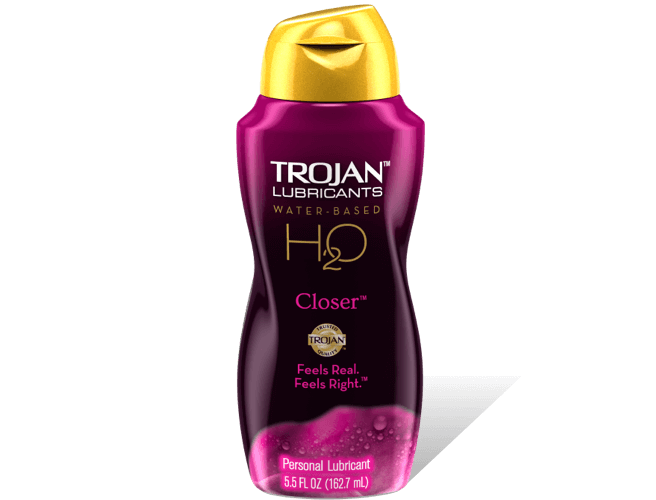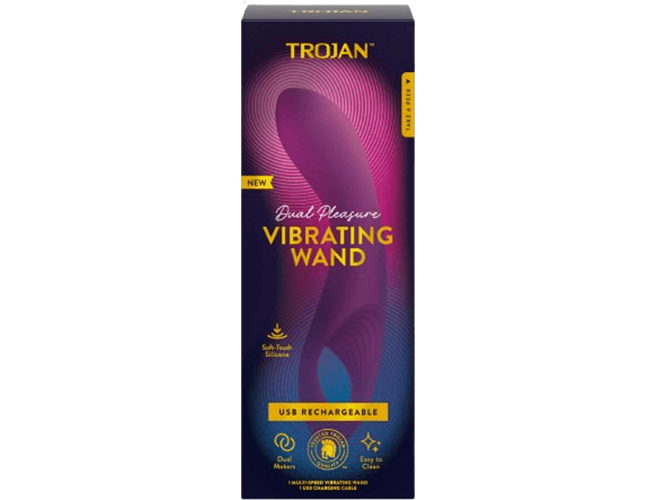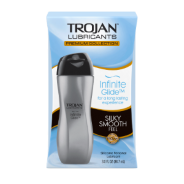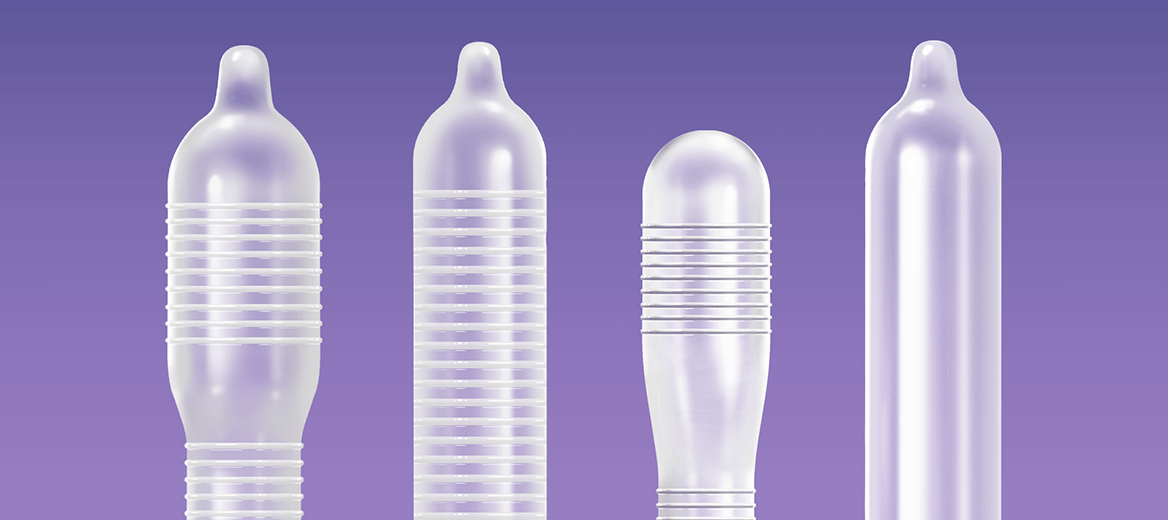Product 101
Latex vs. Non-Latex Condoms: Pros and Cons of Each
.png)
When you need a condom to protect you and your partner from pregnancy and sexually transmitted infections (“STIs”), you have choices for what it’s made of. Most condoms are made of natural rubber latex, but you can also use non-latex condoms made of various polymers, including synthetic rubber and lambskin. It is important to understand that condoms made from lamb, such as Trojan Naturalamb, do not protect against STIs.
Which condom you choose – latex or non-latex – can affect your pleasure and protection, but it’s also a matter of preference for you and your partner and whether you are looking for STI protection.
Before you roll one on your shaft or get a condom near your private parts, know what you’re putting on before you get it on.
What are Condoms Made Of?
More than 80% of condoms are made of natural rubber latex. The other 20% are non-latex condoms, made of lab-synthesized polymers such as polyurethane, polyethylene or polyisoprene (or a combination) or the old-school penis-sheath, lamb.
Latex Condoms
Unless you’re part of the 4.3% of the general population worldwide who are allergic to latex, you can use latex condoms, which are made to optimize strength, stretch, and sensation. Latex condoms are made from rubber from the rubber tree and have been around for more than a century.
Latex makes a great material for condoms because it is super elastic and can be pulled very thin without breaking. It also is a smooth, strong surface that creates a protective barrier to keep away sperm and the germs (bacteria and viruses) that cause sexually transmitted infections.
Latex condoms come in different sizes and shapes, depending on your fit and what you like best for maximum feeling. You’ll find latex condoms with roomier ends (for extra stimulation of the frenulum and head), and with or without lube. Latex condoms also come in different thicknesses depending on whether you’re trying to prolong the pleasure and last longer or have barely anything there.
What are Lambskin Condoms Made Of?
Lambskin condoms are made from a very thin section of lamb intestine, and because it’s a natural membrane like your skin, it can almost feel like it’s not even there. These OG latex-free condoms have been around since the Middle Ages.
Lambskin condoms protect against pregnancy but not against STIs because of the tiny pores in the natural membrane. Lambskin condoms can also be inconsistent in size (both length and width) from condom to condom, since they come from actual sheep and have natural variation.
If you’re looking for a condom designed to heighten sensitivity and you’re not worried about protection from sexually transmitted diseases (maybe you’re in an exclusive and monogamous long-term relationship), lambskin condoms may be a great choice for pleasure and preventing pregnancy.
What are Latex-Free Condoms Made Of?
Most non-latex condoms are made of stretchy, rubber or plastic synthetic polymers. Those polymers are created by synthesizing compounds like isoprene, ethelyne and urethane.
Both latex and non-latex condoms pass the testing to show they prevent pregnancy and STIs. People who have been tested as having a latex allergy or whose skin gets itchy, dry, or develops a rash after contact with latex should choose a non-latex condom.
Polyurethane vs. Synthetic Polyisoprene
Polyurethane condoms are made from a thermoplastic elastomer. Meanwhile, synthetic polyisoprene condoms are made from polymerization of synthetic isoprene. Both are free of the proteins that might cause an allergic reaction for people with latex sensitivity.
Polyisoprene condoms are typically stretchier, thicker and softer than polyurethane condoms. However, those qualities also make them more loose-fitting. Additionally, they can be smelly.
Since they are essentially chemically made, polyisoprene condoms can emit sulfurous odors. It’s not uncommon for polyisoprene condoms to have added fragrances that are meant to offset the chemical odors. Conversely, polyurethane condoms are odorless and thinner than polyisoprene condoms.
Do Polyurethane Condoms Break Easily?
Polyurethane condoms do not break easily. Studies have shown that polyurethane condoms are statistically equivalent to latex condoms in terms of effectiveness.
.png)
Latex vs. Non-Latex Condoms: A Comparison
Both latex and non-latex condoms equally protect against pregnancy. Lambskin non-latex condoms do not protect against STIs, but non-latex condoms made of synthetic polyisoprene and polyurethane protect against sexually transmitted infections as well as latex condoms.
There are more options available for latex condoms, especially in terms of shapes, sizes, and features such as ribs or studs, and they may be more widely available in convenience stores, clinics and certain areas. Both latex and non-latex condoms are available to buy online and in many pharmacies.
Some people are put off by the odor that polyisoprene non-latex condoms often have, especially with oral sex. Those people may prefer polyurethane non-latex condoms, such as Trojan™ Raw™ PureFeel™, or a latex condom. If the condom-wearer or their partner are sensitive to latex, a non-latex condom can help keep your sex safer and still feel great.
Are Non-Latex Condoms Thicker Than Latex Condoms?
Non-latex condoms are typically thicker than latex condoms, with polyisoprene generally being the thickest. Among non-latex condoms that protect against pregnancy and STIs, polyurethane condoms are the thinnest.
Trojan™ Raw™ Pure Feel™ is America’s thinnest non-latex condom and is 50 percent thinner than other leading non-latex brands. It’s designed to conduct and enhance body heat between you and your partner for a more stimulating experience.
What are Trojan™ Condoms Made Of?
Most Trojan™ condoms are made of rubber latex, including Trojan™ BareSkin™, Trojan™ BareSkin™ Raw™, Trojan™ Ecstasy, Trojan™ ENZ and others. For a latex-free Trojan™ condom, try Trojan™ Raw™ Pure Feel™ America’s thinnest non-latex condom among leading non-latex brands, or NaturaLamb, for skin-to-skin pleasure without latex.
What are Magnum™ Condoms Made Of?
All Magnum™ Condoms are made of natural rubber latex, including Magnum™ Raw™, Magnum™ Thin, Magnum™ Ecstasy, Magnum™ BareSkin™, Magnum™ Ribbed, and Magnum™ XL.
Do Non-Latex Condoms Protect Against Pregnancy and STDs?
Non-latex condoms made of polyisoprene, polyurethane, polyethylene or a polymer blend protect against pregnancy and sexually transmitted infections. Non-latex condoms made of lambskin protect against pregnancy but not STIs.
Do Non-Latex Condoms Feel Better?
Whether a latex or a non-latex condom feels better is much more related to whether the condom fits and how thin it is. Three important factors that can help make sex with a condom feel great: friction, wetness and thinness. For the best feeling sex with a latex or non-latex condom, wear one that fits, use a compatible lubricant and choose the condom that feels best for you and your partner.
Latex and Non-Latex Thin Condoms for Maximum Feeling
If you prefer thin condoms, Trojan™ has options for you. The thinnest latex condom available in the United States is Trojan™ BareSkin™ Raw™*and the thinnest non-latex condom you can buy in the US is Trojan™ Raw™ Pure Feel™.* Some people also find that a condom with a roomier head feels best, especially if your penis is uncircumcised. To find the best condom for your pleasure, find your condom size and fit. Of course, if you or your partner are in the 4.3% of people who are allergic to latex, choose a non-latex condom.
*among leading brands (based on 52-week Nielsen data)





